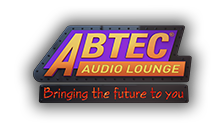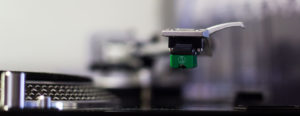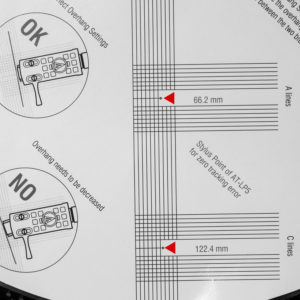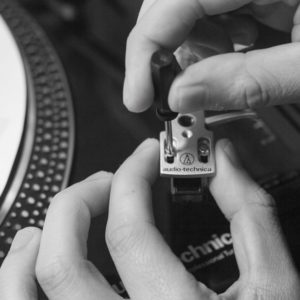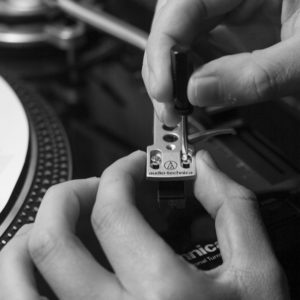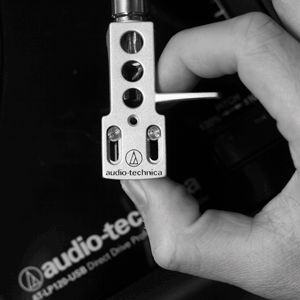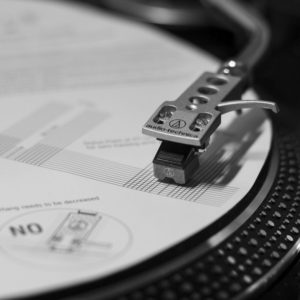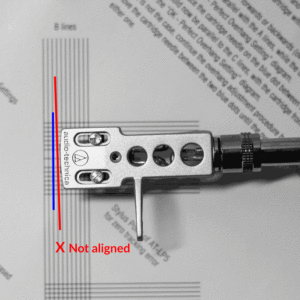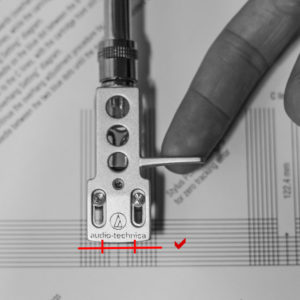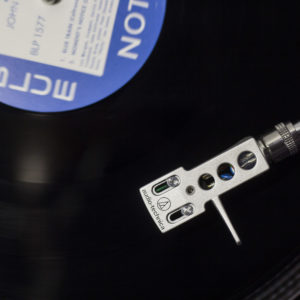Proper alignment of your turntable stylus ensures the most accurate reproduction of the recording and stops it from wearing down immaturely. There are various tools available for achieving this alignment.
Note: Before aligning your cartridge, make sure your turntable is set up properly and the tracking force is adjusted.
Stylus Overhang
At the very least, the specified stylus overhang (the distance the stylus tip extends beyond the centre spindle when the headshell is positioned directly above the spindle) should be set. A simple way to set overhang is to use an overhang gauge that has markings in millimetres (mm). Common stylus overhang distances are 15 mm (as is the case for our AT-LP1240-USB Turntable) and 16 mm (for our AT-LP120-USB turntable), but other lengths exist as well. Note that on a turntable that includes a premounted cartridge/stylus the overhang has typically been preset at the factory.
Tangency
To ensure the most accurate reproduction of the recording, low noise and least amount of wear on the record and stylus, it is important that the stylus is aligned in such a way that its tip remains as tangent to the record groove as possible as it travels across the record. With a pivoted tonearm, it is possible to achieve perfect tangency at only two points as the tonearm travels in an arc across the record. These two points are known as null points (points where there is no tracking error). A two-point cartridge alignment protractor can help achieve this tangency. You can download and print a two-point protractor from our website – just be sure to print the protractor to actual size. The LP5 comes with a printed protractor for convenience.
The two-point protractor has a dot for the stylus tip to rest on and a grid to which the stylus cantilever (the tube that extends from the cartridge body and has the stylus attached to it) aligns. If the stylus cantilever is not easily seen, align the sides of the cartridge body to the lines on the grid instead. In this case, we are assuming that the cantilever is centred and straight as it relates to the sides of the cartridge. Like all two-point protractors, ours has an outer dot/grid and an inner dot/grid. If you choose to use a different protractor, it is important to select one that is suitable for the effective length of the tonearm on your turntable. For the AT-LP120-USB turntable, the effective length is 230.5 mm. For the AT-LP1240-USB Turntable, the effective length is 230 mm. The protractor on our website is suitable for both of these turntables.
With the mounting hardware loose enough to allow forward and backward movement of the cartridge in the headshell, position the cartridge to allow the stylus tip to rest on the protractor’s outer dot (the dot farthest from the center spindle). This will set the correct stylus overhang. Next, align the stylus cantilever to the lines on the grid. If the cantilever is not easily seen, align the sides of the cartridge body to the lines on the grid instead. Provided the stylus tip has been attached properly during manufacturing, the tip will be tangent to the record groove when the cantilever is aligned to the grid. Note that you may need to twist the cartridge slightly in the headshell (when looking down on it from above) to achieve the best alignment to the grid. When done, the cartridge may not necessarily end up being parallel to the headshell.
Once you’ve aligned the cartridge to the outer dot/grid, move the tonearm to the inner dot/grid to double-check that the cartridge and stylus align there as well. They should align to the inner dot/grid without further adjustment. If they don’t, recheck that the stylus overhang has been set correctly, that the headshell is properly attached to the tonearm, and that the stylus is properly attached to the cartridge. Make any necessary adjustments, then recheck the alignment against both the outer and inner dots/grids. This might take a few tries at first but it will be worth it! Once aligned, tighten the mounting hardware until snug.
Then play your favourite record! If your cartridge wasn’t aligned, you’ll hear the difference immediately and it will also help with stabilising the arm, which means no skipping. You’ll rarely need to remove your cartridge and align it again but it’ts always good to check every year or if you move your turntable to a new location.
Tip: If you intend on getting specialised cartridges – like our VM670SP for 78 RPM records – then purchase a dedicated headhsell too for easy installation and you won’t have to re-align the cartridge again.
